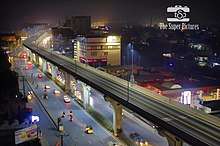Multan Metrobus
The Multan Metrobus (Urdu: مُلتان میٹرو بس), is a bus rapid transit (BRT) system in Multan, Punjab, Pakistan.[1] Construction on the line began in May 2015, while operations commenced on 24 January 2017.[2]
| Multan Metrobus مُلتان میٹرو بس | ||||||||||||||||||||||||||||||||||||||||||||||||||||||||||||||||||||||||||||||||||||||||||||||||||||||||||||||||
|---|---|---|---|---|---|---|---|---|---|---|---|---|---|---|---|---|---|---|---|---|---|---|---|---|---|---|---|---|---|---|---|---|---|---|---|---|---|---|---|---|---|---|---|---|---|---|---|---|---|---|---|---|---|---|---|---|---|---|---|---|---|---|---|---|---|---|---|---|---|---|---|---|---|---|---|---|---|---|---|---|---|---|---|---|---|---|---|---|---|---|---|---|---|---|---|---|---|---|---|---|---|---|---|---|---|---|---|---|---|---|---|---|
| Overview | ||||||||||||||||||||||||||||||||||||||||||||||||||||||||||||||||||||||||||||||||||||||||||||||||||||||||||||||||
| System | Lahore Metrobus | |||||||||||||||||||||||||||||||||||||||||||||||||||||||||||||||||||||||||||||||||||||||||||||||||||||||||||||||
| Operator | Punjab Mass Transit Authority | |||||||||||||||||||||||||||||||||||||||||||||||||||||||||||||||||||||||||||||||||||||||||||||||||||||||||||||||
| Began service | 24 January 2017 | |||||||||||||||||||||||||||||||||||||||||||||||||||||||||||||||||||||||||||||||||||||||||||||||||||||||||||||||
| Route | ||||||||||||||||||||||||||||||||||||||||||||||||||||||||||||||||||||||||||||||||||||||||||||||||||||||||||||||||
| Route type | Bus Rapid Transit | |||||||||||||||||||||||||||||||||||||||||||||||||||||||||||||||||||||||||||||||||||||||||||||||||||||||||||||||
| Locale | Multan, Punjab, Pakistan | |||||||||||||||||||||||||||||||||||||||||||||||||||||||||||||||||||||||||||||||||||||||||||||||||||||||||||||||
| Start | Bahauddin Zakariya University Terminal | |||||||||||||||||||||||||||||||||||||||||||||||||||||||||||||||||||||||||||||||||||||||||||||||||||||||||||||||
| End | Kumharanwala Chowk Terminal | |||||||||||||||||||||||||||||||||||||||||||||||||||||||||||||||||||||||||||||||||||||||||||||||||||||||||||||||
| Stops | 21 | |||||||||||||||||||||||||||||||||||||||||||||||||||||||||||||||||||||||||||||||||||||||||||||||||||||||||||||||
| ||||||||||||||||||||||||||||||||||||||||||||||||||||||||||||||||||||||||||||||||||||||||||||||||||||||||||||||||
Design

The Multan Metro route is 18.5 kilometres (11.5 mi) long, with 12.5 kilometres (7.8 mi) elevated section. It has 21 bus stations, with 14 elevated stations and seven ground level stations. The bus stations have been constructed with Multan’s extreme hot and cold weather in mind.[3] Each bus can carry 190 passengers. A private company will run the bus service for the time being. Nearly 96,000 commuters are expected to use Multan Metrobus service everyday.[4] The official reports reported cost of Rs. 29 billion for 18.5 kilometres (11.5 mi), making it Rs 1.61 billion per Kilometer.
Operational problems of project
Multan metro bus service was started with 47 buses. However, the service was unable to meet its target of 90,000+ passengers. After commence losses, ten buses were sent to the Lahore metro project. Nevertheless, the remaining 37 buses were still unable to attain viable passengers [5]. To prevent the service from collapse, 19 buses were parked and strength was reduced to 18.[6] Further more, 100 more feeder bus services were bought in first phase; feeding passengers to the remaining 18 buses from far flung areas. [7] Latter, 100 more buses was imported to make a total of 200, accommodating all possible routes in Multan. Afterwards, Speedo buses were also reduced from 200 to 115 after few months attributing empty buses and lack of public interest. [8] Despite all measures taken by Punjab government, the project received high annual losses due to subsidised rate provided in the project. Several reasons for failure of project included:
- Poor route planning and design of project. [9]
- Difficult ticketing systems i.e. the electronic card used in the project and expensive card load requirements.
- Qinqi rikshaw operating on same routines as metro bus are cheaper and quicker.
See also
- Rapid transit in Pakistan
- Lahore Metrobus
- Rawalpindi-Islamabad Metrobus
- Karachi Metrobus
- TransPeshawar
References
- "Work on Multan Metro Bus to Begin on August 14". The Nation. Retrieved January 30, 2018.
- "Prime Minister inaugurates Multan Metrobus". Dawn News. Retrieved January 24, 2018.
- http://dunyanews.tv/en/Pakistan/371872-PM-inaugurates-Multan-Metro-Bus-Service
- http://dunyanews.tv/en/Pakistan/371872-PM-inaugurates-Multan-Metro-Bus-Service
- https://www.youtube.com/watch?v=440v2WJu8Vs Metro stations collapsed, feeder buses to revive Multan metro bus: Jaag TV
- https://www.youtube.com/watch?v=2g5VovRtiPc Metro stations desolated , Metro buses reduced to 18 buses: Abb tak
- https://tribune.com.pk/story/1446501/multans-feeder-bus-service-operational-july/ Feeder buses to start operations to help Multan Metro project
- https://www.youtube.com/watch?v=BlfzfFh6cJY&t=63s failure of Speedo bus service: Lahore news
- https://www.newstv.pk/2018/03/27/poorly-designed-route-planning-for-multan-metro-project-failed-to-deliver-27-march-2018/ Poor route plan of Multan metro bus